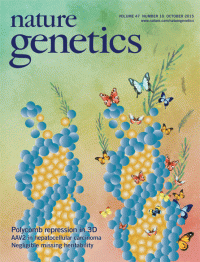 NOTICIAS
NOTICIAS
Shaking up the foundations of epigenetics
-
Researchers at the Centre for Genomic Regulation (CRG) and the University of Barcelona (UB) published a study that challenges some of the current beliefs about epigenetics
- Scientists have discovered that the role of epigenetics is different than normal when regulating genes that are specifically expressed during embryonic development
- Published in the October issue of the journal Nature Genetics, the work is highlighted on the cover with an illustration inspired by the findings of the Catalan researchers and a Salvador Dalí painting
Cells of multicellular organisms contain identical genetic material (the genome) yet can have drastic differences in their structural arrangements and functions. This variation of the distinct cell types comes from the differential expression of genes, which is controlled by interplay between different regulators within the cells, such as transcription factors, the transcription machinery, and the “epigenetic” modifications (which do not change the underlying genetic code) that occur on the DNA and protein factors within chromatin.
In a study co-directed by Roderic Guigó, a CRG principal investigator and a UPF professor, and Montserrat Corominas, at the Department of Genetics of the University of Barcelona (UB) and the Institute of Biomedicine of the UB (IBUB), the scientists show that the chromatin marks are irrelevant for regulating genes that are expressed in a punctual manner during development. The results of this study contrast sharply with the generally accepted view of the key roles that these epigenetic marks play in regulating gene expression.
The project was based on gene expression data from the modENCODE project, which aims to provide the scientific community with a comprehensive encyclopedia of functional elements of the genome of model organisms. In this case, the researchers used data about the genomic expression from the nematode worm C. elegans and the fruit fly D. melanogaster.
"We didn’t set out to study the relationship between the epigenetic chromatin marks and gene expression during development, but rather to analyze the function of these marks in DNA processing. But we soon saw that there were some highly-expressed genes that did not have the epigenetic marks on their chromatin—which are thought to be required to maintain such high levels of expression. We first considered that this could be an experimental artifact, since it is common for developmental genes to be expressed only in a few specific cells, which could lead to the signals from the marks being diluted out and not detected. However, when we analyzed the data from the modENCODE project, we realized that the genes that were regulated during development were indeed expressed even though they lacked the chromatin marks one would expect. A lot of our work has focused on experimentally confirming these results," explains Montserrat Corominas.
Embryonic development is a well-studied process in which the precise regulation of gene expression is critical, since many genes are expressed simultaneously and in a punctual manner. The work from these two research groups in Barcelona now offers novel information for understanding this process, by focusing on a set of genes that act during development and are specific to certain tissues.
"At the present, we already have computer models that help us to predict the patterns of expression for genes based on their chromatin modifications. Our work now adds a new aspect that was previously not even contemplated, which will help us to make predictive models even more reliable," said Roderic Guigó. "Our results are based on the expression of genes in two model organisms. Now we have to see whether what we observed in these two organisms also holds true for humans. If so, the results from our study will be useful for improving approaches to manipulate or modulate the levels of gene expression—which would be extremely useful for studying and treating those diseases that we know are caused by the expression of specific genes,” concluded Guigó.
 The work is published in the October issue of the journal Nature Genetics and is featured on the cover with an illustration by Luisa Lens, which was inspired by the results of the Catalan teams as well as by the Salvador Dali painting “Paisaje de mariposa. El gran masturbador en paisaje surrealista con ADN (Butterfly landscape. The great masturbator in a surrealist landscape with DNA).”
The work is published in the October issue of the journal Nature Genetics and is featured on the cover with an illustration by Luisa Lens, which was inspired by the results of the Catalan teams as well as by the Salvador Dali painting “Paisaje de mariposa. El gran masturbador en paisaje surrealista con ADN (Butterfly landscape. The great masturbator in a surrealist landscape with DNA).”
Reference:
Sílvia Pérez-Lluch, Enrique Blanco, Hagen Tilgner, Joao Curado, Marina Ruiz-Romero, Montserrat Corominas & Roderic Guigó. "Absence of canonical marks of active chromatin in developmentally regulated genes" Nature Genetics. 2015
doi: 10.1038 / ng.3381
Cover image: http://www.nature.com/ng/journal/v47/n10/covers/index.html
Financial support:
This work was supported by the Ministerio de Economía y Competitividad grants BIO2011-26205, CSD2007-00008, BFU2012-36888, and 'Centro de Excelencia Severo Ochoa 2.013-2.017' (SEV-2.012-0208), and the European Union’s Seventh Framework Programme grants of the European Research Council (ERC) project RNA-MAPS (no. 294653) and the collaborative project 4DCellFate (no. 277899).
For further information and interviews:
Centre for Genomic Regulation (CRG) – Communications Office – Laia Cendrós - Ph. +340933160237.
| Adjunto | Tamaño |
|---|---|
| 178.98 KB | |
| 173.16 KB | |
| 190.48 KB |

